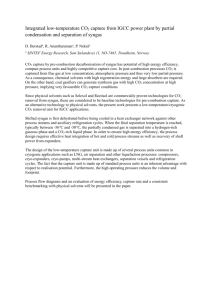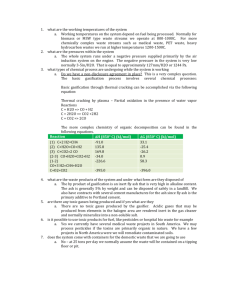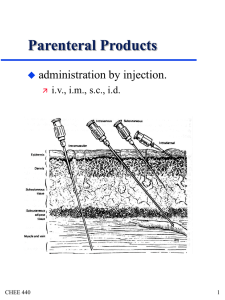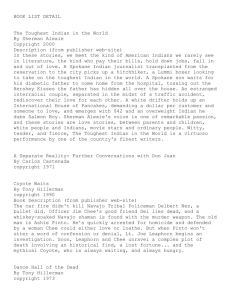Integrated Design Problem:
advertisement
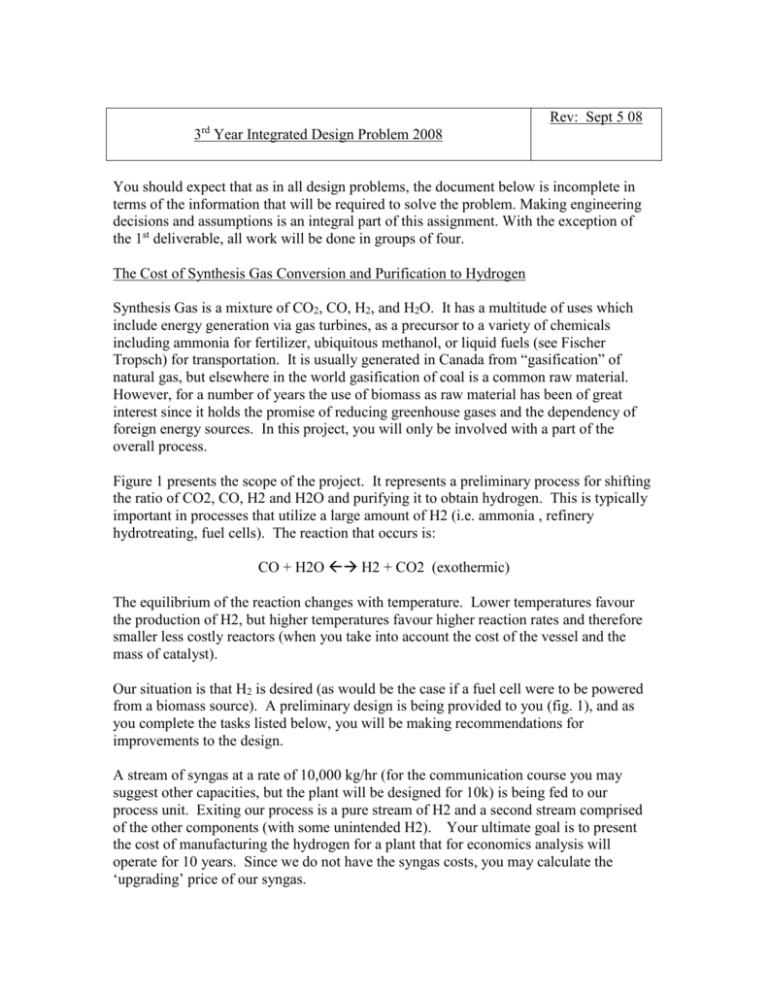
Rev: Sept 5 08 3rd Year Integrated Design Problem 2008 You should expect that as in all design problems, the document below is incomplete in terms of the information that will be required to solve the problem. Making engineering decisions and assumptions is an integral part of this assignment. With the exception of the 1st deliverable, all work will be done in groups of four. The Cost of Synthesis Gas Conversion and Purification to Hydrogen Synthesis Gas is a mixture of CO2, CO, H2, and H2O. It has a multitude of uses which include energy generation via gas turbines, as a precursor to a variety of chemicals including ammonia for fertilizer, ubiquitous methanol, or liquid fuels (see Fischer Tropsch) for transportation. It is usually generated in Canada from “gasification” of natural gas, but elsewhere in the world gasification of coal is a common raw material. However, for a number of years the use of biomass as raw material has been of great interest since it holds the promise of reducing greenhouse gases and the dependency of foreign energy sources. In this project, you will only be involved with a part of the overall process. Figure 1 presents the scope of the project. It represents a preliminary process for shifting the ratio of CO2, CO, H2 and H2O and purifying it to obtain hydrogen. This is typically important in processes that utilize a large amount of H2 (i.e. ammonia , refinery hydrotreating, fuel cells). The reaction that occurs is: CO + H2O H2 + CO2 (exothermic) The equilibrium of the reaction changes with temperature. Lower temperatures favour the production of H2, but higher temperatures favour higher reaction rates and therefore smaller less costly reactors (when you take into account the cost of the vessel and the mass of catalyst). Our situation is that H2 is desired (as would be the case if a fuel cell were to be powered from a biomass source). A preliminary design is being provided to you (fig. 1), and as you complete the tasks listed below, you will be making recommendations for improvements to the design. A stream of syngas at a rate of 10,000 kg/hr (for the communication course you may suggest other capacities, but the plant will be designed for 10k) is being fed to our process unit. Exiting our process is a pure stream of H2 and a second stream comprised of the other components (with some unintended H2). Your ultimate goal is to present the cost of manufacturing the hydrogen for a plant that for economics analysis will operate for 10 years. Since we do not have the syngas costs, you may calculate the ‘upgrading’ price of our syngas. Good design process follows a route of background research and understanding the constraints of the problem followed by idea generation and evaluation. It’s important to understand the intent of the design (business and technical), and how it fits into the larger picture, so that you may make better informed design decisions. Process Details and Deliverables 1) [for CHEE 360, Technical Communications II] Write a concise (less than 3 page) introduction to this design problem that summarizes the major business issues and the technical constraints or optimizations you feel are necessary. This individual report will require research and planning. Due in Week 4, the material can serve as the background section of your final (group) project report and will also be the basis of a CHEE 360 oral group presentation (Week 5-7; exact dates to be announced) in which all members of your group will be asked to speak to an audience knowledgeable in technical and business aspects of the process. You must convince them that you understand the big picture and have a firm grasp of the technical and business challenges, and that you have a plan to complete the project on time and with sufficient quality in your design. Only students registered for CHEE 360 need to complete this section. (For further details, see http://appsci.queensu.ca/courses/engcomm/CHEE360/assignments/index.php and see the slides from the project introduction) 2) The process includes two packed-bed reactors operating in series. As part of CHEE 321, you will explore the tradeoffs between high temperature (faster reaction rates) and low temperature (higher equilibrium conversion) operation. You will also learn how to estimate the pressure drop caused by the catalyst packing, and examine reactor energy balances. This understanding will be useful as you consider the tradeoffs between capital and operating costs of the overall process. A few hints are in order: a. The Ergun equation can be used to determine pressure drops of fluids passing through packed beds. It is helpful to know that as you increase the diameter of the bed, the velocity of the gas decreases, thus the pressure drop decreases. Pressure drop is an important consideration because of the recycle (and the need to keep the H2 at high pressure). b. A part of your report should document the physical dimensions of the reactors. These dimensions are something you need to determine (versus the preliminary values in the model provided to you). The reaction is an equilibrium one, and thus a mixture of reactants and products leave the two reactors. Upon separation, the CO and H2O is recycled back to the reactor feeds. A compressor will be required to offset the pressure drop through the beds and its size and energy requirements are important in the overall economics of this process. c. The reactor design should consider costs (operating and capital). You can assume its tan-tan (straight side) Length to Diameter ratio is 1.5:1 (but other values are acceptable). 3) The Flash System: The method for separating CO2 from the syngas is commonly done by absorbing or reacting the CO2 with a liquid and allowing the CO, H2, and H2O to pass through. CO2 is then separated from the absorbent. One industrial process for separating CO2 is marketed by Dow Chemical as Selexol (other processes utilizing amine solutions such as MDEA also work). Selexol is a physical absorbent and therefore decreasing the temperature and increasing the pressure causes CO2 to dissolve into the liquid. Decreasing the pressure allows the solvent to degas (in the case of amine solutions a reaction occurs and heat is required to reverse the reaction to remove the CO2). Our process utilizes the physical absorbency principle, but there remains some unanswered questions at this time that require answering: a. Determination of Binary Coefficients: The model currently uses the UNIQUAC property package which assumes the fluids are not ideal. The property package (thermodynamic method) utilizes binary coefficients to calculate the gas solubility. The binary coefficients for the component mixtures we are interested in were not in the database. Instead, they have been generated theoretically via the UNIFAC method. You should validate the predicted solubility vs the manufacturer’s data (see attached file). If the solubilities are not correctly calculated you should modify the binary coefficients accordingly. Fig – finished tutorial model b. The number of flash drums and their operating pressure is yet to be confirmed, as is the recirculation rate of Selexol. You should analyze the current design and develop recommendations for improvements. 4) You will be required to provide the design and costs for the heat exchangers. Two methods will be utilized. a. Provide a detailed design for the heat exchanger that cools the recirculating absorbent (“Selexol Cooler”). The detailed design should be for a shell and tube heat exchanger and include the shell diameter, number of tubes, baffle spacing, etc. b. Provide a quick sizing for the other heat exchangers (given heat transfer film coefficients, determine the surface area requirements). Assume the values for flow and pressure etc. that are in your optimized simulation. 5) You should provide a short analysis of the process hazards that are present in this process. 6) You will need to explain your design through a process flow diagram that shows the equipment and major control loops and a short description of how design works. Attachments: Included with this assignment is a UNISIM simulation file. The Final Report: The final project report will be marked for CHEE 321, CHEE 311 and CHEE 318; a portion of your grade will be course specific, and a portion will be assigned to your overall design and discussion. The report will eventually be marked, after a round of feedback and individual editing, for CHEE 360 in the winter term. (CHEE 360 in the winter term also includes an individual presentation based upon your project.) The report will be submitted electronically (format to be confirmed later) to the applied science communication course website, as well as by hardcopy (5 copies). The report should be as concise as possible (< 15 pages in 12 point Times New Roman font, not including appendices). It should have the following content: (This list is preliminary, and may be modified later in the semester.) 1. An executive summary (½ to 1 page) 2. Project background – problem definition and brief summary of background research 3. A process flow diagram (complete with the major control loops) and brief description explaining how the process works. 4. Identification of process hazards. 5. The major assumptions, a summary of conclusions and findings of your work (including the financial analysis), leaving most of the calculations for appendices. 6. (Optional) Recommendations for future work. 7. Appendices of related engineering calculations, clearly stating all assumptions. Calculations should be complete and written so they can be followed by someone other than yourself. Indicate how you provided quality assurance in your calculations. Fig 1: Preliminary Process Flow Diagram




